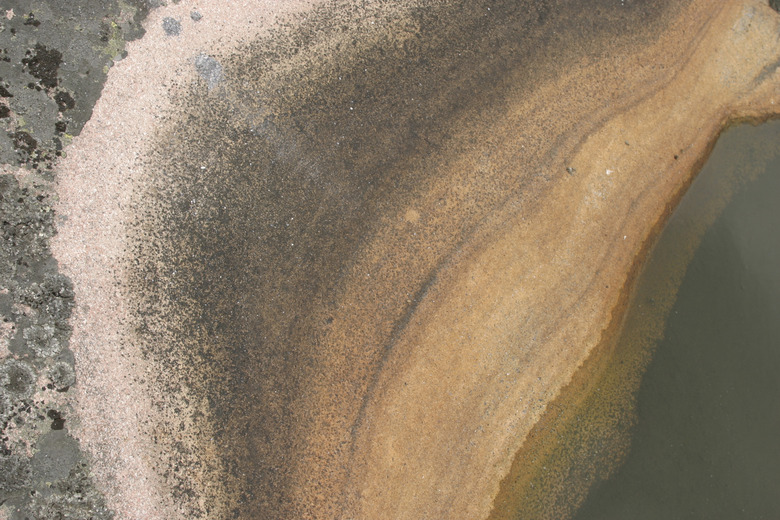How To Test For Water Pollution From Sewage
Sewage pollution significantly impacts waterways and human health. It adds excess nutrients to aquatic ecosystems, causing algae, bacteria and protozoa to grow out of control. This overgrowth robs water of oxygen, leading to massive animal die-off. The resultant dead zones are almost impossible to undo. Sewage also contains many disease-causing organisms, and once they've entered a waterway, their entrance into our drinking water is virtually guaranteed. Sorting out which pollution originates with sewage, however, is tricky business.
Looking from Space
Looking from Space
One way to test for water pollution from sewage is to look at waterways from space. Satellite images show plumes of material where runoff meets water — brown ones contain sediment, which is likely to include sewage. This method is sometimes used after major polluting events, such as toxic spills and natural disasters with flooding. However, there's no way to know for sure how much of these plumes is sewage pollution and how much is silt. The satellite imaging method allows for only a rough estimate of potential sewage pollution.
Counting Bugs
Counting Bugs
"Thermotolerant coliforms" is the polite term for bacteria that live in feces, otherwise known as fecal coliforms. The problem with testing for them is that false positives are high. Similar bacteria are widely broadcast in the general environment — in other words, they live in dirt as well as in all animal feces, and wild animals from insects to mammals are everywhere. Escherichia coli is a common indicator species for fecal coliform tests, but still environmentally ubiquitous; tests for bacteria of the Enterococcus genus are considered best because these organisms are found in the feces of all mammals, but very seldom elsewhere. Enterococcus tests are currently considered the gold standard for monitoring sewage pollution in waterways, but they leave out a major component of sewage pollution: ammonia and nitrogen.
Ammonia
Ammonia
It's possible to determine whether water pollution may originate with sewage by testing for ammonia because most sewage treatment facilities in the U.S. do not remove urine when they process waste water. The urine decays into ammonia, so high ammonia levels can indicate a sewage source for a particular instance of pollution. False positives are also possible with this test, however, since other sources, such as animal feeding operations, create high levels of ammonia pollution, and agricultural and municipal runoff contribute large amounts of ammonia's end product, nitrogen.
Test Shortcomings
Test Shortcomings
The main problem with trying to test for water pollution from sewage is that it's usually impossible to determine exactly where the pollution came from by the time it enters a body of water. Some can be traced back to poor municipal disposal systems, but only when there's an obvious "smoking gun," such as an open pipe pouring sewage into a waterway. Most sewage pollution results from overflow and occupies the vague category "nonpoint source pollution" along with storm drain outflow and agricultural runoff. Satellite imaging, fecal coliform and ammonia testing can all predict a probability that particular pollution is sewage-sourced, but they have no way to screen out organic runoff, fertilizer and animal feces.
A Healthy BOD?
A Healthy BOD?
There may be a better way. The biochemical oxygen demand test counts decomposer bacteria in water as it leaves sewage treatment plants. The number of bacteria gives an estimate both of how much sewage remains in the water, and its potential biological impact once it reaches a waterway and the bacteria start using up oxygen there. However, the test is only used in a truncated form in the U.S. A complete BOD counts carbon-eating and nitrogen-eating bugs: carbon is from feces and nitrogen is from urine. The test currently in use counts only carbon-eaters, which leaves sewage pollution from urine entirely outside of the calculations. Switching to a complete BOD could help pinpoint exactly which pollution comes from sewage: it would give an accurate picture of how much is leaving treatment facilities, and researchers could match observed impacts in habitats downstream with the impacts predicted by the BOD counts.
References
- Scientific American: Satellites Track Hurricane Sandy Water Pollution
- Emlab P&K: The Environmental Reporter – Screening for Sewage Contamination
- Riverkeeper: How is the Water? 2012 – Sewage Contamination in the Hudson River Estuary 2006 – 2011
- Encyclopedia Britannica: Water Pollution – Sewage and Other Water Pollutants
Cite This Article
MLA
Libal, Angela. "How To Test For Water Pollution From Sewage" sciencing.com, https://www.sciencing.com/test-water-pollution-sewage-5033/. 24 April 2017.
APA
Libal, Angela. (2017, April 24). How To Test For Water Pollution From Sewage. sciencing.com. Retrieved from https://www.sciencing.com/test-water-pollution-sewage-5033/
Chicago
Libal, Angela. How To Test For Water Pollution From Sewage last modified March 24, 2022. https://www.sciencing.com/test-water-pollution-sewage-5033/
